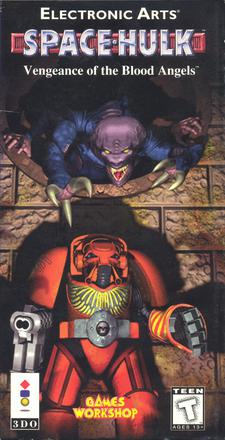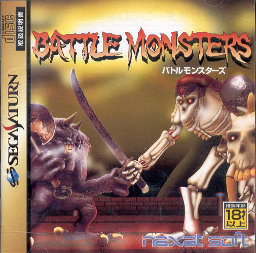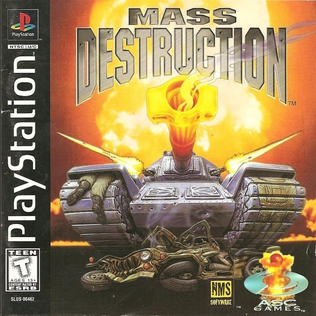
X-Men vs. Street Fighter is a crossover fighting video game developed and published by Capcom. It is Capcom's third fighting game to feature Marvel Comics characters, following X-Men: Children of the Atom and Marvel Super Heroes, and is the first installment in the Marvel vs. Capcom series. As the title suggests, the game includes characters from Marvel's X-Men franchise and the cast from Capcom's Street Fighter series. Originally released as a coin-operated arcade game in 1996, it was ported to the Sega Saturn in 1997 and the PlayStation in 1998. The original arcade version is included in the game lineup for Marvel vs. Capcom Fighting Collection: Arcade Classics, released for the Nintendo Switch, PlayStation 4 and Windows in 2024.
Panasonic M2, earlier known as 3DO M2, is a multimedia terminal and cancelled video game console. It was initially developed by The 3DO Company as a peripheral chip for the 3DO hardware before turning into a standalone successor system. In January 1996, the technology was acquired by Matsushita (Panasonic) who continued development as their own game console before cancelling it altogether in 1997. The M2 technology was then incorporated into commercial-oriented devices including a Konami arcade board and in interactive kiosks.

Primal Rage is a fighting game developed and released by Atari Games for arcades in 1994. The game takes place on a post-apocalyptic version of Earth called "Urth". Players control one of seven prehistoric beasts, that battle each other to determine the planet's fate. Matches feature many of the conventions of fighting games from the era, including special moves and gory finishing maneuvers. Ports were released for home video game consoles and personal computers. Efforts to perfectly emulate the arcade original have been unsuccessful due to the use of an unusual copy protection method. Toys, comics, a novel and other merchandise tie-ins were produced. More than 1.5 million copies of the game were sold.

Marvel Super Heroes is a 1995 fighting game developed and published by Capcom. Originally released in the arcade on the CPS-2 arcade system, it was ported to the Sega Saturn and PlayStation in late 1997. The game, alongside Marvel vs. Capcom: Clash of Super Heroes, was also included in the Marvel vs. Capcom Origins collection, released digitally for the PlayStation 3 and Xbox 360 in September 2012.

War Gods is a 3D fighting video game originally released to arcades by Midway Games in 1996. Ports for the Nintendo 64, PlayStation and Windows were released in 1997. In the game, players control one of ten fighters who have been given great power by a mysterious ore that crashed-landed on Earth from outer space. The object of the game is to defeat all the other fighters to become the most powerful warrior on the planet.

Saturn Bomberman is an action video game by Hudson Soft for the Sega Saturn as the name implies. The twelfth installment in the Bomberman series, it was first released in Japan on July 19, 1996, in Europe in May 1, 1997, and in North America in September 4, 1997. It is best known for its multiplayer functionality for up to ten players. The game received praise from critics for its enjoyable gameplay and multiplayer, but received criticism for not advancing the Bomberman series enough beyond previous installments.

Madden NFL 98 is a 1997 football video game. It was the last edition of the Madden series to be released for the Super NES, Genesis and Sega Saturn platforms, as well as the last Madden game to utilize 2D sprites for the players and referee, on 3D playing fields.

Space Hulk: Vengeance of the Blood Angels is a video game published by Electronic Arts in 1995 for the 3DO, which was later ported to PlayStation, Sega Saturn, and Microsoft Windows. It is based on Games Workshop's board game Space Hulk and is the sequel to the 1993 video game Space Hulk. Like its predecessor, Vengeance of the Blood Angels combines first-person shooter gameplay with real-time tactical elements. Space Hulk: Vengeance of the Blood Angels is part of the Warhammer 40,000 universe.

X2 is an arcade-style side-scrolling shoot 'em up released during the Team17-Ocean collaboration era of video games that created the Worms series. It is the sequel to the Amiga shooter Project-X. Unlike its predecessor, this game was a console exclusive. Acclaim Entertainment was slated to publish the game in North America, but it was never released in that region. A Sega Saturn version of the game was scrapped during development, at least in part due to Acclaim withdrawing support for the Saturn.

MechWarrior 2: 31st Century Combat is a vehicle simulation game developed and published by Activision, released in 1995 as part of the MechWarrior series of video games in the BattleTech franchise. The game is set in 3057, and is played as a tactical simulation that incorporates aspects of real-time first-person combat and the physical simulation of the player's mech. It is a game recreation of the "Refusal War." The player can join one of the clans, Clan Jade Falcon or Clan Wolf while engaging in up to 32 missions.

The Need for Speed is a 1994 racing game developed by EA Canada, originally known as Pioneer Productions, and published by Electronic Arts for 3DO. It was later ported to other platforms with additional tracks and cars, including to MS-DOS, PlayStation, Sega Saturn, and Microsoft Windows in 1996, on which it was subtitled SE.

Battle Monsters (バトルモンスターズ) is a versus fighting game developed by Scarab for the Sega Saturn. It was originally published by Naxat Soft in Japan and later published in North America and Europe by Acclaim Entertainment. Similar to Atari's Pit-Fighter, the game makes heavy use of digitized human actors as the characters, plus some blood influenced by Midway's Mortal Kombat series. The game features 12 playable fighters, and plays out on multi-tiered stages.

NHL 97 is an ice hockey video game by EA Sports. It was released in 1996 and was the successor to NHL 96. It is the sixth installment of the NHL series and the first to be released on both PlayStation and Saturn. A Panasonic M2 version was in development and slated to be one of the launch titles for it, but never happened due to the cancellation of the system.

Shockwave Assault is a science fiction combat flight simulation video game developed by Advanced Technology Group and published by Electronic Arts for various home video game consoles and PCs. The player takes control of a futuristic fighter plane to defeat extraterrestrial ships and tripods.

BattleSport is a 1996 futuristic sports video game developed by Cyclone Studios. It was originally published by Studio 3DO exclusively for their 3DO Interactive Multiplayer in 1996, but after the 3DO was discontinued BattleSport was published for other systems by Acclaim Entertainment. It was released for Windows and PlayStation, Sega Saturn, and Windows in North America in July 1997, and in Europe on August 1, 1997.

Mass Destruction is a 1997 third-person action game developed by NMS Software and published by ASC Games and BMG Interactive. Released for MS-DOS, the Sega Saturn, and the PlayStation, the game puts players in control of a tank, and tasks them with destroying enemy forces. It has often been likened to Return Fire.

Re-Loaded is a science fiction-themed top-down multidirectional shooter developed by Gremlin Interactive and published by Interplay. A sequel to Loaded, it was released in 1996 for the PlayStation and MS-DOS, and later on PlayStation Network. A Sega Saturn version was in development, but was cancelled.

Road Rash is a 1994 racing and vehicular combat video game originally published by Electronic Arts (EA) for the 3DO Interactive Multiplayer. A version for the Sega CD was developed simultaneously and released in 1995 to act as a "bridge" between the 3DO version and the Sega Genesis title Road Rash 3, and the game was subsequently ported to the PlayStation, Sega Saturn, and Microsoft Windows in 1996. The game is the third installment in the Road Rash series, and is centered around a series of motorcycle races throughout California that the player must win to advance to higher-difficulty races, while engaging in unarmed and armed combat to hinder the other racers.

















